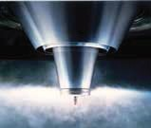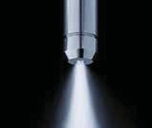Spray Drying solutions for R & D and Production
Mumbai, Maharashtra
Monday to Saturday
support@copious.com
Copious Melbourne, New Yourk
Monday to Saturday
support@copious.com
Copious Melbourne, New Yourk
Monday to Saturday
One of the most important choices in a plant configuration is choosing the right atomization and powder discharge method. We offer a wide range of solutions, as illustrated.

In rotary atomization, the feed is centrifugally accelerated to high velocity in the atomizer wheel before being discharged into the hot drying gas. The degree of atomization and particle morphology depends upon peripheral speed, feed rate, liquid properties and atomizer wheel design. Particle size is adjusted by changing the peripheral speed. The rotary atomizer, considered the most flexible atomizing device, is suitable for a wide range of products. Rotary atomizers will generally deliver a narrower particle size distribution and more free flowing powder than two fluid nozzles.
Two-fluid nozzle atomization is achieved pneumatically by high-velocity compressed air/gas impacting the liquid feed. Particle size is controlled by varying the nozzle flow ratio between atomizing gas and feed. When operating in co-current mode, the nozzle tip is placed close to the outlet of the ceiling air disperser. The co-current mode is selected when drying heat-sensitive products. When coarse particles of a non-heat sensitive feed are required, the two-fluid nozzle in fountain mode is appropriate.


With a pressure nozzle, atomization is the result of the conversion of pressure energy within the liquid feed into kinetic energy of a moving thin liquid sheet. Pressure applied to the liquid within the nozzle forces the liquid out of the orifice creating the atomization. A pressure nozzle can be operated in co-current mode or in fountain mode. Particle size is adjusted by changing the feed pressure and nozzle size. Pressure nozzles will generally Deliver a narrower particle size distribution and coarser particles than other atomizer Pressure nozzle types.